Railway Freight
ONE-STOP GLOBAL LOGISTICS PROVIDER
China Railway Transport
Railway freight from China has become one of the most efficient, reliable, and cost-effective transportation solutions for businesses shipping goods to Europe, Russia, and Central Asia. As global trade continues to evolve, the demand for stable and scalable logistics has never been greater. Tonlexing, a leader in international logistics, recognizes the growing importance of China–Europe rail transport as a key link between major global markets. Rail freight offers the ideal balance between speed and cost, bridging the gap between slower sea freight and the higher expenses of air freight.
In this comprehensive guide, Tonlexing provides everything you need to know about railway freight from China—covering transit times, pricing, LCL options, customs procedures, and best practices to ensure your shipments arrive safely and efficiently.

Table of Contents
Guide to Rail Freight from China to Europe, Russia, and Central Asia
In the fast-paced world of global trade, efficient and reliable logistics solutions are essential for maintaining a competitive edge. Rail freight has emerged as a strategic option for businesses looking to transport goods from China to Europe, Russia, and Central Asia. Combining the speed of air freight with the cost-effectiveness of sea freight, rail transport offers a balanced solution that meets the demands of modern supply chains. This comprehensive guide will walk you through everything you need to know about rail freight, from transit times and costs to handling special cargo and navigating customs procedures. Whether you’re considering full container loads (FCL) or less than container loads (LCL), this guide provides the insights and details necessary to make informed decisions about your logistics strategy.
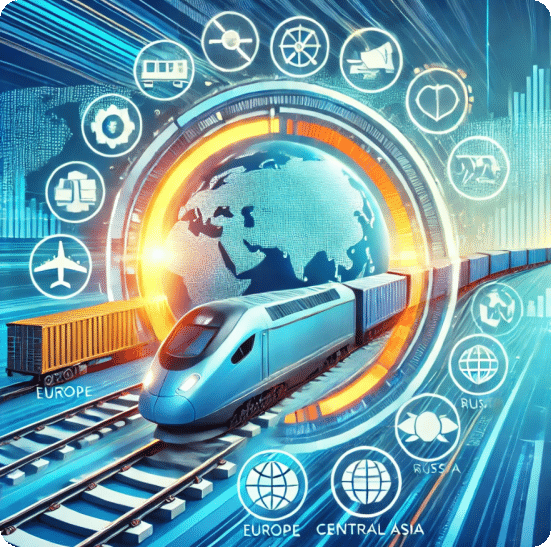
How Long Does Rail Freight Take from China to Europe and Russia?
Rail freight transit times from China to Europe and Russia vary based on the specific routes and destinations. Rail transport offers a faster alternative to sea freight and a more cost-effective option compared to air freight, making it an attractive choice for many businesses.
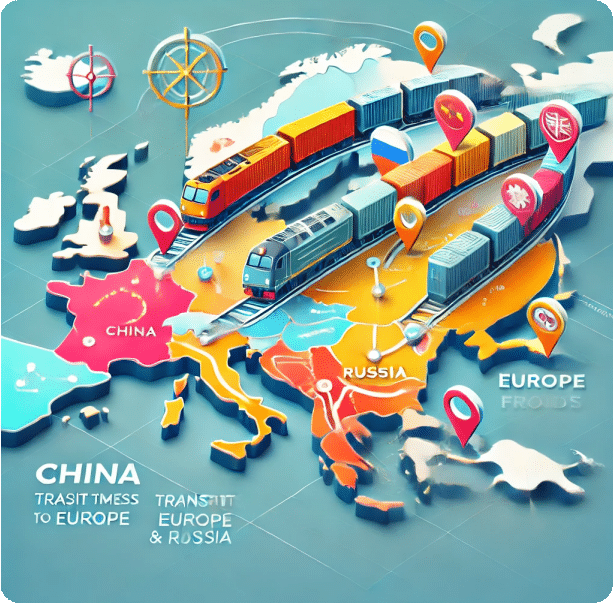
China to Europe Rail Freight Transit Times
| Route | Major Stations | Transit Time (Days) |
|---|---|---|
| Chengdu to Lodz (Poland) | Chengdu → Xi’an → Lanzhou → Urumqi → Alashankou → Dostyk (Kazakhstan) → Moscow (Russia) → Brest (Belarus) → Warsaw → Lodz | 12-14 |
| Yiwu to Madrid (Spain) | Yiwu → Zhengzhou → Xian → Urumqi → Alashankou → Dostyk (Kazakhstan) → Moscow (Russia) → Minsk (Belarus) → Warsaw (Poland) → Hamburg (Germany) → Duisburg → Madrid | 18-20 |
| Chongqing to Duisburg (Germany) | Chongqing → Zhengzhou → Xian → Lanzhou → Urumqi → Alashankou → Dostyk (Kazakhstan) → Moscow (Russia) → Minsk (Belarus) → Warsaw (Poland) → Duisburg | 15-17 |
| Zhengzhou to Hamburg (Germany) | Zhengzhou → Xian → Lanzhou → Urumqi → Alashankou → Dostyk (Kazakhstan) → Moscow (Russia) → Minsk (Belarus) → Warsaw (Poland) → Hamburg | 15-16 |
| Wuhan to Lyon (France) | Wuhan → Zhengzhou → Xian → Urumqi → Alashankou → Dostyk (Kazakhstan) → Moscow (Russia) → Minsk (Belarus) → Warsaw (Poland) → Duisburg (Germany) → Lyon | 18-20 |
China to Russia Rail Freight Transit Times
| Route | Major Stations | Transit Time (Days) |
|---|---|---|
| Chengdu to Moscow | Chengdu → Xi’an → Lanzhou → Urumqi → Alashankou → Dostyk (Kazakhstan) → Yekaterinburg (Russia) → Moscow | 11-13 |
| Yiwu to Saint Petersburg | Yiwu → Zhengzhou → Xian → Urumqi → Alashankou → Dostyk (Kazakhstan) → Moscow → Saint Petersburg | 16-18 |
| Harbin to Vladivostok | Harbin → Suifenhe → Ussuriysk (Russia) → Vladivostok | 5-7 |
| Chongqing to Novosibirsk | Chongqing → Zhengzhou → Xian → Lanzhou → Urumqi → Alashankou → Dostyk (Kazakhstan) → Novosibirsk (Russia) | 12-14 |
Note: Transit times are approximate and can be affected by factors such as customs clearance, weather conditions, and rail traffic.
What are the Rail Freight Rates from China to Europe and Russia?
Rail freight rates depend on various factors, including the route, distance, type of goods, and current market conditions. Below are estimated rates for standard 40-foot containers, now adjusted to be more competitive.
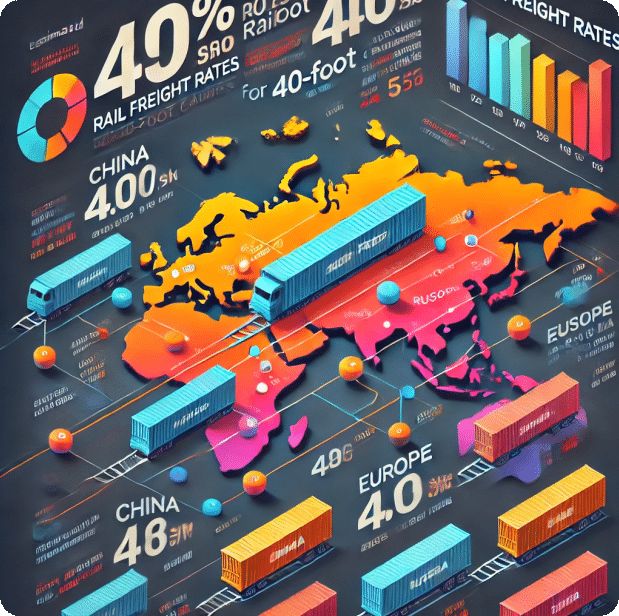
Estimated Rail Freight Rates from China to Europe
| Route | Cost (USD per 40ft Container) |
|---|---|
| Chengdu to Lodz (Poland) | $4,000 – $5,000 |
| Yiwu to Madrid (Spain) | $5,500 – $6,500 |
| Chongqing to Duisburg (Germany) | $4,500 – $5,500 |
| Zhengzhou to Hamburg (Germany) | $4,500 – $5,500 |
| Wuhan to Lyon (France) | $5,000 – $6,500 |
Estimated Rail Freight Rates from China to Russia
| Route | Cost (USD per 40ft Container) |
|---|---|
| Chengdu to Moscow | $3,800 – $4,800 |
| Yiwu to Saint Petersburg | $4,500 – $5,500 |
| Harbin to Vladivostok | $1,500 – $2,500 |
| Chongqing to Novosibirsk | $3,500 – $4,500 |
LCL (Less than Container Load) Rail Freight: An Economical Option
For businesses that do not require a full container, LCL rail freight offers a cost-effective and flexible solution. This option allows businesses to share container space with others, making it ideal for smaller shipments.
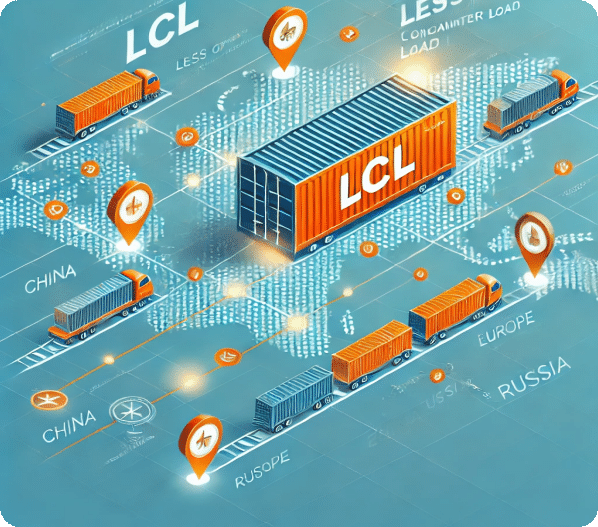
Estimated LCL Rail Freight Rates
| Route | Cost (USD per CBM) | Minimum Shipment Volume | Transit Time (Days) |
|---|---|---|---|
| Chengdu to Lodz (Poland) | $150 – $200 | 1 CBM | 12-14 |
| Yiwu to Madrid (Spain) | $180 – $250 | 1 CBM | 18-20 |
| Chongqing to Duisburg (Germany) | $160 – $220 | 1 CBM | 15-17 |
| Zhengzhou to Hamburg (Germany) | $160 – $220 | 1 CBM | 15-16 |
| Wuhan to Lyon (France) | $180 – $250 | 1 CBM | 18-20 |
| Chengdu to Moscow (Russia) | $140 – $180 | 1 CBM | 11-13 |
| Yiwu to Saint Petersburg (Russia) | $150 – $200 | 1 CBM | 16-18 |
Note: Prices are indicative and may vary based on factors like fuel costs and market demand. For the most accurate pricing, it’s best to get a quote from a reliable logistics provider.
Advantages of LCL Rail Freight
- Cost Efficiency: By only paying for the space your goods occupy, LCL rail freight allows businesses to benefit from the advantages of rail transport without the cost of a full container.
- Flexibility: LCL shipments offer greater flexibility in terms of volume and shipping frequency, making it easier for businesses to manage their logistics.
- Accessibility: LCL services are widely available on major rail routes, providing access to multiple destinations across Europe and Russia.
Weight Limits for Rail Freight: Single Items and Full Containers
Rail freight has specific weight limits that must be adhered to:
- Single Item Weight Limit: 1.5 tons per item. This limit ensures safe handling and transport across the rail network.
- Full Container Weight Limit: 26 tons per 40-foot container. Exceeding this limit could result in additional fees or require special handling arrangements.
These weight restrictions are in place to ensure the safe and efficient transport of goods by rail, preventing overloading and minimizing the risk of damage during transit.
What Customs Procedures are Required for Rail Freight from China?
Efficient customs clearance is crucial for timely rail freight delivery. Here’s a step-by-step guide to the customs procedures involved:
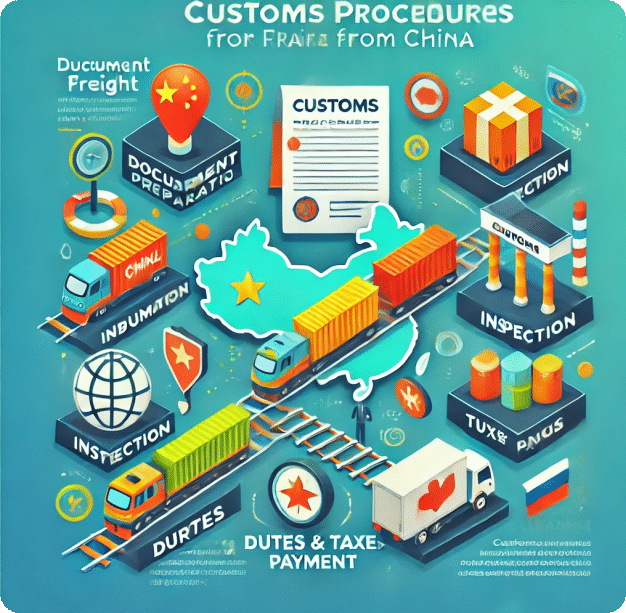
Documentation Preparation
- Commercial Invoice: Details of the goods, including description, value, and quantity.
- Packing List: Specifies the packaging details, weight, and dimensions.
- Bill of Lading (Railway Waybill): Contract of carriage between the shipper and carrier.
- Certificate of Origin: Indicates where the goods were produced.
- Customs Declaration Form: Official document declaring the goods for export/import.
Export Customs Clearance in China
- Submission of Documents: All necessary documents are submitted electronically or in paper form to Chinese customs authorities.
- Inspection: Customs may conduct physical inspections to verify the goods match the documentation.
- Duties and Taxes: Applicable duties and taxes are assessed and paid.
- Clearance Approval: Once approved, goods are allowed to depart China.
Transit Customs Procedures
- Transit Documents: During transit through other countries (e.g., Kazakhstan, Belarus), transit declarations and accompanying documents are required.
- Sealing and Inspection: Containers are usually sealed, and transit countries may perform inspections as per their regulations.
Import Customs Clearance at Destination
- Document Submission: Importers submit required documents to the destination country’s customs authorities.
- Inspection: Customs may inspect the goods to ensure compliance with local regulations.
- Duties and Taxes Payment: Import duties, VAT, and other taxes are calculated and must be paid.
- Release of Goods: After successful clearance, goods are released for final delivery.
Tips for Smooth Customs Clearance:
- Accurate Documentation: Ensure all documents are accurate and complete to avoid delays.
- Understand Regulations: Be aware of the customs regulations and requirements of both exporting and importing countries.
- Work with Experienced Freight Forwarders: Partnering with knowledgeable logistics providers can streamline the process.
Can You Ship Hazardous and Refrigerated Goods by Rail Freight?
Yes, rail freight services can accommodate a wide range of goods, including hazardous and refrigerated items. Here’s how:
Shipping Hazardous Goods
- Compliance with Regulations: Rail transport for hazardous materials must comply with the International Regulations concerning the Carriage of Dangerous Goods by Rail (RID). These regulations ensure the safe handling, transport, and storage of dangerous goods.
- Proper Classification and Labeling: Goods must be properly classified according to their hazard class, with appropriate labeling and packaging to prevent accidents during transport.
- Required Documentation: Shipping hazardous goods requires specific documentation, including Material Safety Data Sheets (MSDS), a Dangerous Goods Declaration, and a transport emergency card (TREM Card).
- Specialized Containers: Hazardous goods must be transported in containers specifically designed to handle such materials, ensuring safety throughout the journey.
Shipping Refrigerated Goods
- Refrigerated Containers (Reefers): Rail freight services offer refrigerated containers equipped with advanced temperature control systems, ensuring that temperature-sensitive goods remain within the required range throughout transit.
- Continuous Monitoring: These containers are often equipped with monitoring systems that provide real-time updates on temperature conditions, allowing for immediate action if any issues arise.
- Ideal for Perishables: Refrigerated rail freight is particularly suitable for transporting perishable goods such as fresh produce, dairy products, pharmaceuticals, and other items that require a controlled environment.
Benefits of Shipping Special Goods by Rail
- Enhanced Safety: Rail transport is considered one of the safest methods for transporting hazardous materials, as it reduces the risks associated with road and air transport.
- Reliable Schedules: Rail freight services often adhere to strict schedules, ensuring timely delivery of goods, which is critical for both hazardous and refrigerated shipments.
- Environmental Considerations: Rail freight has a lower carbon footprint compared to other modes of transport, making it a more sustainable option for transporting sensitive or dangerous goods.
Why Choose Rail Freight Over Sea and Air Freight for Shipping from China?
Rail freight offers several advantages that make it a preferred choice for businesses looking to optimize their logistics operations. Here’s why:
Time Efficiency
- Faster than Sea Freight: Rail freight typically reduces transit times by about 50% compared to sea freight. For example, shipments from China to Europe can take as little as 12-20 days by rail, compared to 30-45 days by sea.
- Ideal for Time-Sensitive Goods: Rail freight is perfect for businesses that need to get their products to market quickly but cannot afford the high costs associated with air freight.
Cost-Effectiveness
- Cheaper than Air Freight: Rail freight costs are significantly lower than air freight, often by as much as 50-70%. This makes it a cost-effective solution for transporting large volumes of goods.
- Competitive Pricing: With adjusted pricing that is now more competitive, rail freight offers excellent value for businesses looking to optimize their shipping budgets.
Reliability
- Regular Schedules: Rail freight offers regular and predictable schedules, which helps businesses plan their supply chains more effectively.
- Lower Risk of Delays: Compared to sea freight, rail transport is less susceptible to delays caused by port congestion, weather conditions, or other disruptions.
Environmental Sustainability
- Lower Carbon Footprint: Rail freight is one of the most environmentally friendly modes of transport, producing significantly lower CO2 emissions than both air and road transport.
- Supporting Green Logistics: By choosing rail freight, businesses can reduce their environmental impact and align with global sustainability goals.
Accessibility
- Extensive Network: Rail networks connect key industrial hubs in China directly to major cities across Europe, Russia, and Central Asia, reducing the need for additional road transport.
- Multiple Route Options: The expansion of the New Silk Road has opened up several rail corridors, providing businesses with flexible routing options.
Detailed Overview of LCL (Less than Container Load) Rail Freight
For businesses that don’t need to ship full containers, LCL rail freight offers an economical and flexible solution. Here’s a closer look at how LCL works and what it costs.
What is LCL Rail Freight?
- Shared Container Space: In LCL shipping, your goods share container space with other shipments. This is ideal for smaller shipments that do not require a full container.
- Cost-Effective: Since you only pay for the space your goods occupy, LCL is a more affordable option for smaller loads.
- Flexible Shipping: LCL allows businesses to ship smaller quantities more frequently, which can be beneficial for managing inventory and cash flow.
LCL Rail Freight Rates
| Route | Cost (USD per CBM) | Minimum Shipment Volume | Transit Time (Days) |
|---|---|---|---|
| Chengdu to Lodz (Poland) | $150 – $200 | 1 CBM | 12-14 |
| Yiwu to Madrid (Spain) | $180 – $250 | 1 CBM | 18-20 |
| Chongqing to Duisburg (Germany) | $160 – $220 | 1 CBM | 15-17 |
| Zhengzhou to Hamburg (Germany) | $160 – $220 | 1 CBM | 15-16 |
| Wuhan to Lyon (France) | $180 – $250 | 1 CBM | 18-20 |
| Chengdu to Moscow (Russia) | $140 – $180 | 1 CBM | 11-13 |
| Yiwu to Saint Petersburg (Russia) | $150 – $200 | 1 CBM | 16-18 |
Note: Prices are indicative and subject to change based on fuel costs, demand, and other economic factors. For accurate pricing, it’s recommended to request a quote from a reliable freight forwarder.
Benefits of LCL Rail Freight
- Cost Savings: Ideal for businesses with smaller volumes, allowing them to benefit from rail freight without paying for an entire container.
- Flexibility: LCL provides flexibility in shipping schedules and volume, making it easier to meet specific logistics needs.
- Access to More Destinations: LCL services are available on most major rail routes, giving businesses access to a wide range of destinations without the need for full container loads.
Choosing the Best Rail Freight Service Provider
Selecting the right logistics partner is crucial for successful rail freight shipping.
Factors to Consider
- Experience and Expertise: Look for providers with extensive experience in rail freight and knowledge of international regulations.
- Network Coverage: Ensure the provider has comprehensive network connections covering your desired origins and destinations.
- Service Flexibility: Choose a provider that offers tailored solutions, including door-to-door services and the ability to handle various cargo types.
- Tracking and Communication: Opt for providers with real-time tracking systems and proactive communication throughout the shipping process.
- Cost Transparency: Seek out providers that offer clear and competitive pricing without hidden fees.
Why Choose Tonlexing for Your Rail Freight Needs?
- Proven Track Record: Tonlexing has years of experience in facilitating efficient and reliable rail freight services between China, Europe, and Russia.
- Extensive Network: Our wide-reaching connections cover major cities and industrial hubs across multiple countries.
- Customized Solutions: We offer tailored services to meet specific shipping requirements, including special cargo handling and LCL options.
- Dedicated Support: Our professional team provides end-to-end support and guidance through the entire shipping process.
- Advanced Technology: Tonlexing uses state-of-the-art tracking and logistics management systems to ensure transparency and control over your shipments.
Conclusion: Why Rail Freight is the Right Choice for Your Business
Rail freight offers a reliable, cost-effective, and efficient transportation solution for businesses looking to ship goods from China to Europe, Russia, and Central Asia. Its combination of speed, affordability, and flexibility makes rail freight an increasingly popular choice for international logistics. By choosing the right route and working with experienced logistics partners like Tonlexing, businesses can optimize their supply chains and ensure timely delivery of their goods.
China-Europe Rail Transport: FAQ
Answer: Rail freight is faster than sea freight and significantly cheaper than air freight. It offers a middle-ground solution, combining the speed of air transport with the cost-effectiveness of sea transport, making it ideal for businesses needing reliable and timely deliveries without the high costs of air freight.
Answer: The transit time for rail freight from China to Europe typically ranges from 12 to 20 days, depending on the specific route and destination. This is much faster than sea freight, which can take 30-45 days, and offers a more consistent schedule compared to other transport modes.
Answer: LCL rail freight allows businesses to share container space with other shipments, making it a cost-effective option for smaller loads. You only pay for the space your goods occupy, which makes it ideal for shipping smaller quantities more frequently.
Answer: Rail freight typically has a weight limit of 1.5 tons for single items and 26 tons for a full 40-foot container. These limits ensure safe handling and transport, preventing overloading and minimizing the risk of damage during transit.
Answer: Customs procedures for rail freight include the preparation and submission of necessary documentation (such as the commercial invoice, packing list, and bill of lading), inspection of goods, payment of duties and taxes, and clearance approval. Each country involved in the transit may have specific requirements, so it’s essential to work with experienced logistics providers to ensure smooth clearance.
For personalized rail freight solutions and accurate quotes, contact Tonlexing today and discover how we can streamline your international shipping needs.


